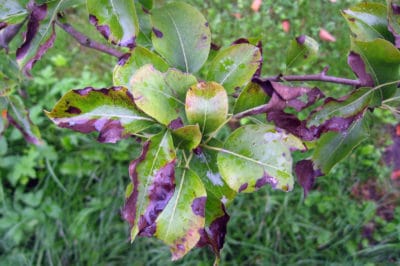What is Fire Blight?
Fire blight is a bacterial infection caused by the organism Erwinia amylovora. This bacteria over-winters in the bark of your trees and emerges in the spring ready to infect branches and blooms.
The name for this disease comes from the fact that infected branches brown, wilt, and look as if they’ve been burned. It infects all members of the rose family including roses, raspberry, hawthorn, serviceberry, apples, and pears.
Symptoms
Recognizing this disease early can make all the difference in the long run. The earlier you can begin to sanitize and quarantine the better chances your tree has of making it.
- Die back of tree top and new tips
- Leaves brown and die but hang onto tree
- Blossoms and shoots wilt and die turning brown
- Lesions on wood that ooze brown liquid
If you notice these symtoms on your pear tree, it may have fire blight. Immediate action should be taken if the tree is to be saved.
Treatment
Prune out all infected branches of the tree to one foot beyond where the infection stops. Burn this material. Do not prune the tree as you regularly would for new growth. New growth is an attractant for the bacteria so while the tree is fighting it should not be encouraged to produce new growth. For this same reason do not fertilize with a heavy-nitrogen fertilizer.
Immediately sanitize all your garden tools. Even if you don’t plan on using them on the tree. If they were stored next to a tool that is used on the tree, it’s better to be safe and ensure your other plants don’t get infected.
If caught early enough, applications of liquid copper sprayed onto the tree will help to combat the bacteria. Spray once a week throughout the spring. Commercial organic and inorganic biocides are available for extreme cases.
Prevention
Prevention is always better than treatment. If you live in a region where pears are commercially produced or where fire blight is a problem, consider planting resistant varieties. This will give you some peace of mind.
Healthy trees are less susceptible to infection. Soil that is compacted, waterlogged, or too dry is an invitation for disease. When planting your trees take extra care to work the soil well and amend it with well-draining material. Water and feed your trees regularly with organic fertilizers.
